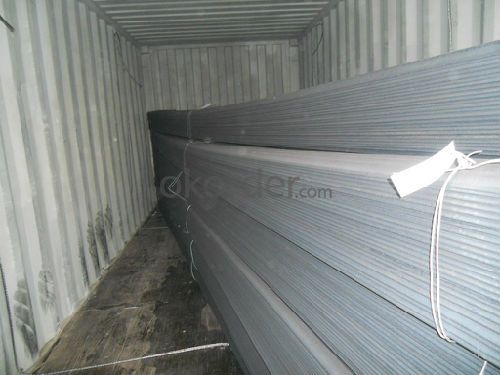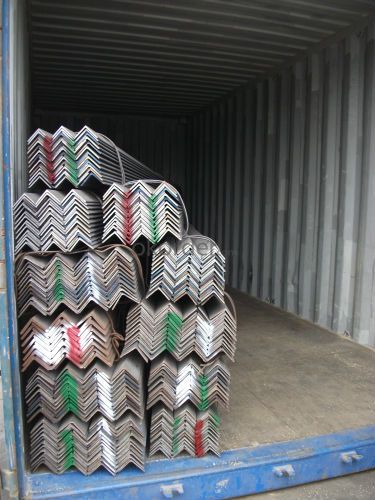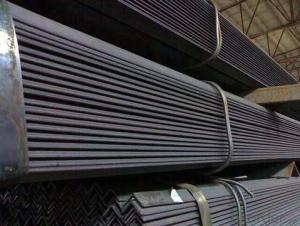SS400 Material High Quality Angle Bar
- Loading Port:
- Tianjin
- Payment Terms:
- TT or LC
- Min Order Qty:
- 25 m.t.
- Supply Capability:
- 2000 m.t./month
OKorder Service Pledge
OKorder Financial Service
You Might Also Like
Product Description:
OKorder is offering Angle Steel great prices with worldwide shipping. Our supplier is a world-class manufacturer of steel, with our products utilized the world over. OKorder annually supplies products to European, North American and Asian markets. We provide quotations within 24 hours of receiving an inquiry and guarantee competitive prices.
Product Applications:
According to the needs of different structures, Angle can compose to different force support component, and also can be the connections between components. It is widely used in various building structures and engineering structures such as roof beams, bridges, transmission towers, hoisting machinery and transport machinery, ships, industrial furnaces, reaction tower, container frame and warehouse etc.
Product Advantages:
OKorder's Angle Steelare durable, strong, and resist corrosion.
Main Product Features:
· Premium quality
· Prompt delivery & seaworthy packing (30 days after receiving deposit)
· Corrosion resistance
· Can be recycled and reused
· Mill test certification
· Professional Service
· Competitive pricing
Product Specifications:
1. Invoicing on theoretical weight or actual weight as customer request
2. Length: 6m, 9m, 12m as following table
3. Sizes
Sizes: 25mm-250mm | ||
a*t | ||
25*2.5-4.0 | 70*6.0-9.0 | 130*9.0-15 |
30*2.5-6.6 | 75*6.0-9.0 | 140*10-14 |
36*3.0-5.0 | 80*5.0-10 | 150*10-20 |
38*2.3-6.0 | 90*7.0-10 | 160*10-16 |
40*3.0-5.0 | 100*6.0-12 | 175*12-15 |
45*4.0-6.0 | 110*8.0-10 | 180*12-18 |
50*4.0-6.0 | 120*6.0-15 | 200*14-25 |
60*4.0-8.0 | 125*8.0-14 | 250*25 |
Alloy No | Grade | Element (%) | |||||
C | Mn | S | P | Si | |||
|
|
|
|
|
|
| |
Q235 | B | 0.12—0.20 | 0.3—0.7 | ≤0.045 | ≤0.045 | ≤0.3 | |
|
|
|
|
|
|
| |
Alloy No | Grade | Yielding strength point( Mpa) | |||||
Thickness (mm) | |||||||
≤16 | >16--40 | >40--60 | >60--100 | ||||
≥ | |||||||
|
|
|
|
|
| ||
Q235 | B | 235 | 225 | 215 | 205 | ||
Alloy No | Grade | Tensile strength (Mpa) | Elongation after fracture (%) | ||||
Thickness (mm) | |||||||
| ≤16 | >16--40 | >40--60 | >60--100 | |||
≥ | |||||||
|
|
|
|
|
|
| |
Q235 | B | 375--500 | 26 | 25 | 24 | 23 | |
Packaging & Delivery of Angle Bar
Packaging Detail: All goods are packed in bundle with steel strips and shipped by break bulk vessel or container (depend on target market and different ports)
Delivery Detail: 45 days
Trade terms: FOB, CFR, CIF
Payment:
-Invoicing on theoretical weight or actual weight as customer’s request.
-FOB, CFR or CIF.
-Regular terms of payment:
1, 30% payment in advance, the remaining balance (70% payment) against the copy of B/L. 100% payment before shipment.
2, 30% payment in advance, the remaining balance (70% L/C) against the copy of B/L. 100% payment before shipment.
3, Negotiable.
FAQ:
Q1 How soon can we receive the product after purchase?
A1 Within three days of placing an order, we will begin production. The specific shipping date is dependent upon international and government factors, but is typically 7 to 10 workdays.
Q2: How do we guarantee the quality of our products?
A2: We have established an advanced quality management system which conducts strict quality tests at every step, from raw materials to the final product. At the same time, we provide extensive follow-up service assurances as required.
Q3: How soon can we receive the product after purchase?
A3: Within three days of placing an order, we will begin production. The specific shipping date is dependent upon international and government factors, but is typically 7 to 10 workdays.
Images:


- Q:What is the difference between hot-rolled and cold-rolled steel angles?
- The main difference between hot-rolled and cold-rolled steel angles lies in the manufacturing process. Hot-rolled steel angles are formed at high temperatures, making them less precise in terms of dimensions and surface finish. Cold-rolled steel angles, on the other hand, are formed at room temperature, resulting in more precise dimensions and a smoother surface finish. Additionally, hot-rolled steel angles are generally more cost-effective, but cold-rolled steel angles offer improved strength and durability.
- Q:What are the different types of steel angles used in transmission line towers?
- Transmission line towers commonly utilize various types of steel angles to provide structural support and stability. These angles are specifically designed to withstand the weight of the transmission lines and the environmental conditions they are exposed to, ensuring the tower's durability. 1. Equal leg angle: This angle features two legs of equal length, forming a right angle. Its simple design and easy fabrication make it a widely used choice in transmission line towers. 2. Unequal leg angle: In this type of angle, the legs have unequal lengths, creating an acute or obtuse angle. Unequal leg angles are employed in transmission line towers that require specific load-bearing capabilities. 3. Bulb angle: Characterized by a bulbous end, bulb angles offer additional strength and stability. They are commonly used in critical areas of transmission line towers, such as the base or connection points, where extra support is needed. 4. Lipped angle: Lipped angles have an extended lip on one side, increasing their load-bearing capacity. They are commonly employed in transmission line towers that require enhanced strength and stability. 5. Back-to-back angle: Back-to-back angles consist of two equal leg angles joined with their flanges touching. This configuration creates a wider angle, providing improved load-bearing capabilities and resistance to bending. It is often selected for transmission line towers that need to support higher loads or longer spans. Each type of steel angle has its own unique characteristics and advantages, allowing engineers to select the most suitable angle for the specific tower design requirements. Careful consideration of these angles ensures the overall strength, stability, and durability of the transmission line tower, facilitating the reliable and efficient transmission of electricity.
- Q:Are steel angles suitable for historical restoration projects?
- Historical restoration projects can benefit from the suitability of steel angles. These versatile and durable materials are ideal for enhancing structural support and reinforcement in historic buildings. In fact, they can be employed to revive or duplicate original architectural elements like window frames, ornamental railings, and decorative features. Moreover, steel angles can be custom-made to perfectly match the original design, seamlessly merging with the existing structure. Nonetheless, it is crucial to take into account the specific demands and regulations of the historical restoration project, as some preservation authorities may impose limitations on the use of contemporary materials. Seeking guidance from experts in historical restoration and obtaining the necessary approvals will guarantee the appropriate and effective utilization of steel angles in preserving the historical integrity of the building.
- Q:Can steel angles be used in window frames?
- Yes, steel angles can be used in window frames. Steel angles are commonly used in construction and can provide structural support and stability to window frames. They are often used as reinforcements or brackets to connect the window frame to the wall or to other components of the window system. Steel angles are durable, strong, and resistant to corrosion, making them a suitable choice for window frame construction. Additionally, steel angles can be easily customized and fabricated to fit different window sizes and designs.
- Q:What is the typical thickness of the base of a steel angle?
- The typical thickness of the base of a steel angle can vary depending on the specific application and requirements. However, in general, the base thickness of a steel angle commonly ranges from 1/8 inch to 3/8 inch. It is important to note that this range is not exhaustive and there may be cases where the base thickness falls outside of these parameters. Factors such as the size, load-bearing capacity, and intended use of the steel angle will influence the base thickness required for a particular project or structure. Therefore, it is crucial to consult engineering specifications or professional guidance to determine the appropriate base thickness for a steel angle in a specific application.
- Q:Can steel angles be used as support beams?
- Yes, steel angles can be used as support beams in construction and structural engineering projects. They are commonly used for their strength and load-bearing capabilities, providing stability and support to various structures such as buildings, bridges, and frameworks.
- Q:What is the typical thickness of the flanges of a steel angle?
- The thickness of the flanges of a steel angle can differ depending on the particular application and industry norms. Typically, flanges of a steel angle are often available in thicknesses ranging from 1/8 inch to 3/4 inch. It is significant to consider that thicker flanges offer greater strength and stability, but also contribute to the weight and cost of the steel angle. To determine the suitable flange thickness, one should consider the specific project requirements and any relevant engineering or design standards.
- Q:Can steel angles be used as reinforcements in masonry walls?
- Yes, steel angles can be used as reinforcements in masonry walls. Steel angles are commonly used to provide additional strength and stability to masonry structures. They are often embedded within the mortar joints or anchored into the masonry units to enhance the overall structural integrity of the wall. The steel angles help to distribute and resist the forces acting on the wall, such as lateral loads or bending moments, making them a reliable choice for reinforcement in masonry construction.
- Q:What are the common shapes and dimensions of steel angles?
- Steel angles are commonly available in a variety of shapes and dimensions to suit various applications. The most common shapes of steel angles are L-shaped or right angles, with equal legs or unequal legs. These angles are typically formed by bending a piece of steel into the desired shape. In terms of dimensions, steel angles can vary in size depending on their intended use. The length of the legs, which are the two sides of the angle, can range from a few inches to several feet. The thickness or gauge of the steel used to make angles can also vary, with thinner gauges being more lightweight and thicker gauges providing greater strength. The most common dimensions for steel angles include: - Equal Leg Angles: These angles have legs of equal length, forming a 90-degree angle. Common sizes for equal leg angles range from 1/2 inch to 6 inches in leg length, with thicknesses ranging from 1/8 inch to 1/2 inch. - Unequal Leg Angles: These angles have legs of different lengths, forming a 90-degree angle. The longer leg is typically referred to as the "vertical leg" and the shorter leg as the "horizontal leg." Common sizes for unequal leg angles range from 1 inch to 6 inches in vertical leg length, with thicknesses ranging from 1/8 inch to 1/2 inch. It's important to note that these dimensions are just a general guideline, and steel angles can be custom-made to meet specific requirements. Additionally, steel angles can be hot-rolled or cold-formed, which affects their structural properties and manufacturing processes. Therefore, it's essential to consult the specific standards and regulations applicable to your project or industry when selecting steel angles.
- Q:What are the different methods for cleaning steel angles?
- To effectively clean steel angles, one can employ various methods: 1. Mechanical Cleaning: By utilizing tools like wire brushes, sandpaper, or abrasive wheels, one can physically scrub away dirt, rust, or contaminants from the steel angles. This method is ideal for light cleaning and can be done manually or with the assistance of power tools. 2. Chemical Cleaning: Stubborn stains, rust, or corrosion on steel angles can be eliminated using chemicals. Acid-based cleaners, such as phosphoric acid or hydrochloric acid, are commonly employed for this purpose. It is crucial to handle these chemicals with care and follow the manufacturer's instructions to ensure safety and prevent any damage to the steel. 3. Electrolytic Cleaning: This method involves immersing the steel angles in an electrolyte solution and applying an electrical current. The electrical current causes the rust or contaminants to dissolve and separate from the surface. Electrolytic cleaning is particularly effective for heavily rusted steel angles, but specialized equipment may be required. 4. High-Pressure Water Cleaning: By utilizing high-pressure water jets, dirt, grime, and loose rust can be effectively removed from steel angles. This environmentally friendly method does not require the use of chemicals. However, it may not be as effective for stubborn stains or heavy corrosion. 5. Blasting: Blasting entails propelling abrasive particles, such as sand, grit, or beads, at high speeds onto the surface of the steel angles. This process aids in the removal of rust, paint, and other contaminants. It is commonly used for heavy-duty cleaning or surface preparation before painting or coating. Choosing the appropriate method depends on the level of contamination, the condition of the steel angles, and the desired outcome. In some instances, a combination of methods may be necessary to achieve optimal results.
1. Manufacturer Overview |
|
|---|---|
| Location | |
| Year Established | |
| Annual Output Value | |
| Main Markets | |
| Company Certifications | |
2. Manufacturer Certificates |
|
|---|---|
| a) Certification Name | |
| Range | |
| Reference | |
| Validity Period | |
3. Manufacturer Capability |
|
|---|---|
| a)Trade Capacity | |
| Nearest Port | |
| Export Percentage | |
| No.of Employees in Trade Department | |
| Language Spoken: | |
| b)Factory Information | |
| Factory Size: | |
| No. of Production Lines | |
| Contract Manufacturing | |
| Product Price Range | |
Send your message to us
SS400 Material High Quality Angle Bar
- Loading Port:
- Tianjin
- Payment Terms:
- TT or LC
- Min Order Qty:
- 25 m.t.
- Supply Capability:
- 2000 m.t./month
OKorder Service Pledge
OKorder Financial Service
Similar products
New products
Hot products
Related keywords




























